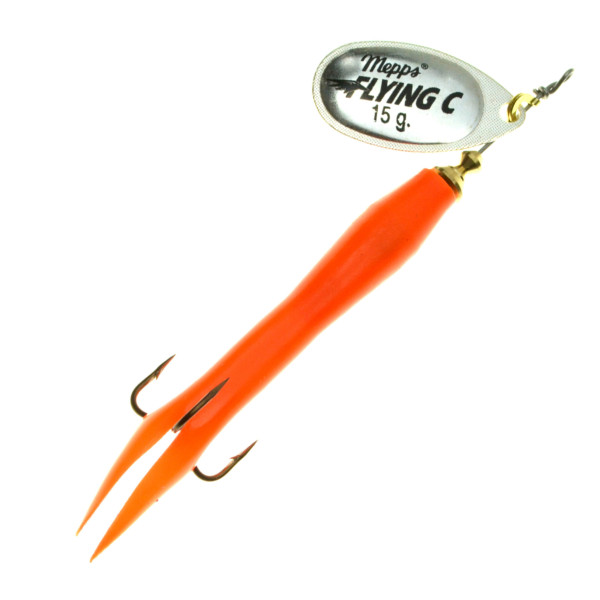The Flying Condom - a name familiar to every salmon angler today, even most fly fishermen. Originally used in Alaska and the Pacific Northwest when fishing for Pacific salmon and steelhead, it quickly became one of the most successful spinning lures there. It didn't take long for it to become an absolute best seller and favorite lure for many salmon anglers on the Altantic side and in Europe as well. The Mepps Flying C is a heavyweight spinner that flies extremely far and stays deep throughout the retrieve. In fact, it is one of Mepps' deepest running spinners because it is specifically designed for fishing rivers with strong currents and deep pools. Its bright, fluorescent sleeve acts like a highly reflective attractant. In addition to the strong vibration and reflective effect of the spinner blade, the Flying C also sets colorful accents. Especially in deeper water layers, where less light penetrates, this can make the difference.
The Flying C is available in three different weight classes: 10 g, 15 g and 25 g. The bodies are made of solid brass and the silver spinner blade is made of genuine silver plate. All Flying C's are equipped with a strong, short-shanked treble hook that sits extremely tight in the salmon's mouth and reduces the risk of slipping out.
Details:
- Successful spinning lure for salmon, sea trout and steelhead.
- Spinner blade made of genuine silver plate
- Body made of dense brass
- Sleeve Color: orange
- Available weights: 10 g, 15 g, and 25 g
Every angler is likely to stumble across this name rather sooner than later. No wonder, because the traditional lures do not only have a long history of success behind them, they are still incredibly effective and fill countless tackle boxes today. As early as 1938, French engineer Andre Meulnard invented the first spinner, which utilized a small metal blade rotating around its own axis. The lure was deadly effective, but he could not yet foresee how much this small lure would revolutionize the fishing industry. It wasn't until after World War II that American Todd Sheldon got his hands on the lure in 1951. A soldier brought the spinner from Europe back to Wisconsin in his home country, where it quickly became a huge success. Today, the small metal lures hang in fishing stores around the world in all shapes, sizes and colors, true to the original principle.











